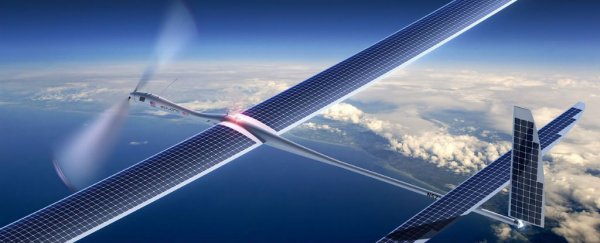Google's been secretly trialling a drove of 5G Internet-compatible drones out in New Mexico that have the potential to transmit gigabits of data every second - that's 40 times more data than the world's fastest wireless services.
Codenamed Skybender, the project aims to take advantage of high frequency millimetre waves - a specific region on the electromagnetic spectrum that can theoretically transmit data far more efficiently than the frequencies our phones and wireless Internet have well and truly clogged up.
"The huge advantage of millimetre wave is access to new spectrum, because the existing cellphone spectrum is overcrowded. It's packed and there's nowhere else to go," electrical engineer Jacques Rudell from the University of Washington, who's not involved in the project, told Mark Harris at The Guardian.
In the electromagnetic spectrum, millimetre waves occupy the frequency spectrum from 30 GHz to 300 GHz, which is between microwaves (1 GHz to 30 GHz) and infrared (IR) waves, which makes them longer than infrared waves or x-rays, but shorter than radio waves or microwaves.
The problem with continuing to use wireless communication the way we have is that every kind of communication, whether it's radio transmissions, television, phone, or satellite, occupies a specific range of wavelengths or frequencies, and providers are given their own 'channel' within these to prevent interference.
But the more information that needs to be transmitted, the more bandwidth you're going to be taking up in this 'prime real estate' region of the spectrum, which means if we want to beam down more data faster, we're going to have to look elsewhere. The Engineering and Technology History Wiki explains:
"For example, a telephone conversation requires only about 6 kHz of bandwidth, while a TV broadcast, which carries much larger amounts of information, requires about 6 MHz. (A kilohertz, is 1,000 cycles per second; a megahertz is 1 million cycles per second). Increases in the amount of information transmitted require the use of higher frequencies. This is where millimetre waves come in."
While millimetre waves are theoretically awesome, and exactly what we need to jettison the Internet into the future, they come with a rather large limitation - they have a much shorter range than mobile phone signals, which means they fade after travelling just a short distance.
According to The Guardian, Google's Skybender tests at Spaceport America in New Mexico found that a broadcast at 28GHz would fade in around a tenth the distance of a 4G phone signal.
But they're not giving up that easy. While the exact details of Skybender are still very much under wraps, Rudell says an educated guess would be that they're trying to figure out how to use a team of high-flying drones to beam down focussed '5G' transmissions in a phased array configuration. "This is very difficult, very complex and burns a lot of power," he says.
Difficult, but not impossible, it would seem, because the US Defense Force has been all over it since 2012. Its research arm, DARPA, has since announced that it's working on a project called Mobile Hotspots, which would provide millimetre wave communications to troops in remote areas via drones, giving them access to wireless speeds of around 1 Gb per second.
According to Engadget, Google has permission from the Federal Communications Commission (FCC) to continue testing their drones in US airspace till July this year, at which point we'll probably hear more about the success or failure of Skybender. Regardless of what happens though, we get the feeling that those millimetre waves aren't going to be left vacant for much longer.
